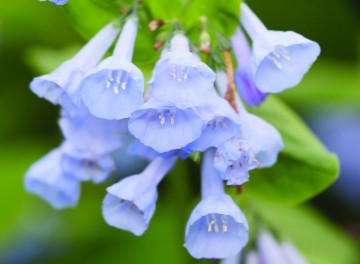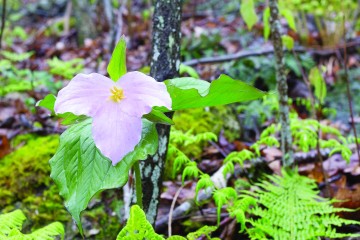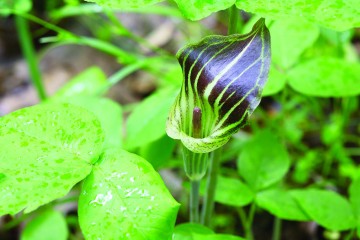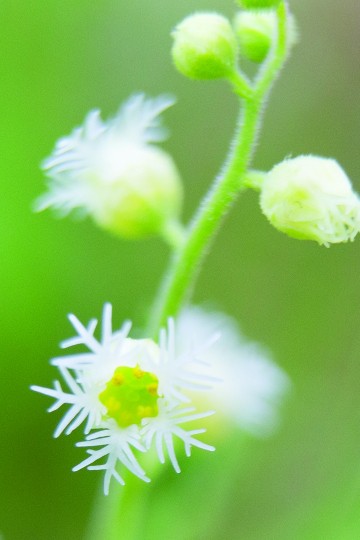Chesapeake Country Abloom
Spring is the season of renewal, a time of birth, regrowth and color. Along the shores of the Chesapeake, you’ll see an osprey, nesting material clinched in its powerful talons. Within the forest, your auditory sense is soothed to the music of returning songbirds, while the sweet scent of spring rain stimulates the olfactory nerves. The landscape is adorned with a visual bouquet of flowering dogwood and redbud trees, and the forest floor is carpeted in a dazzling display of spring wildflowers, the focus of this article.
One of my favorite naturalist pastimes is searching for wildflowers. A wildflower treasure hunt is an excellent way to get the whole family, especially children, involved with the natural world. Find your own woods, or visit Historic London Town and Gardens in Edgewater for a walk through their woodland gardens at your own leisure.
“If you are on a self-guided tour, we can provide you with a wildflower plant ID key, and on guided tours we try to highlight the blooms for the season as well as upcoming ones,” says director of horticulture Meenal Harankhedkar.
Seize the Day
Many spring wildflowers are ephemeral, meaning they are short-lived or display for only a limited time. As the temperature outside rises, the flowers bloom. After only a few weeks, they return to dormancy. This is what makes locating them even more exciting on a forest walk. As the season progresses new species will bloom, giving you a different experience in your search for species.
By early to mid-March as the ground begins to thaw, a surefire sign that winter is losing its chilling grip, one of the earliest flowers to bloom in this region is the round-lobed hepatica. The flower’s blossoms come in a range of pastel colors, from blue, pink, white or lavender. At the base of the plant are greenish-purple, three-lobed leaves. These leaves’ resemblance to a particular organ are why this wildflower is colloquially referred to as liverleaf or liverwort and at one time was used to treat liver disease.
As March progresses, you may catch other glimpses of purple in the form of iris and the common blue violet.

Moving into April, one of my favorites, the trumpet-looking Virginia bluebell, appears in areas with rich soil and plenty of moisture. The plant is pink as it begins to bloom but develops into a stunning pastel blue. At about knee-high, this wildflower is difficult to miss.
While searching, look at the ground for the gorgeous spring beauty. This low-growing wildflower has white to pink flowers and, upon closer inspection, brilliant dark pink stripes. As it can grow in various habitats, it can guide you into wildflower spotting.

Look also for large-flowered trilliums, the wildflower with striking petals that reach three inches long. In fact, the number three is what makes a trillium, well, a trillium. They have three petals, three sepals and three leaves. The petals will either be white or light or dark pink. Trilliums can be grown in ornamental gardens. But never pick a wild one, or you will surely kill it.

Perhaps the most interesting looking April wildflower is the Jack-in-the-pulpit. Its most fascinating feature is its cylindrical leaf structure, called a spathe. From within the spathe emerges a spike known as a spadix in botanical terms. The spadix, or Jack, contains very small yellow flowers at its base and is held within the hooded spathe, aka the pulpit.

As April turns into May, visit boggy areas to look for miterwort, one of the most intricate wildflowers I have encountered. Look at the delicate snowflake-like flowers with a magnifying glass to appreciate its marvelous design.
May is also the time to look for our native orchids. Maryland orchids do not hang from trees; we have terrestrial (meaning growing from the ground) species. Many Maryland orchid species are endangered or have been extirpated from the state, so treat them with care, and leave only footprints if you are lucky to find them.
Perhaps the most popular species is the pink lady’s slipper, and it is a gasp-inducer for sure with its large magenta flower. It takes many years for these plants to grow from seed to gorgeous orchid, and they can live in a variety of wild habitats, from deciduous forest to rocky slopes. A closely related species, but less common, is the yellow lady’s slipper.
Another member of the orchid family to look for is the showy orchis. Its purple and white blooms are smaller than a lady slipper’s but no less breathtaking. They grow in wooded environments; I have encountered them directly on trails. Like all orchids, the petals of showy orchis are very delicate, so do not touch them. Do appreciate their beauty and sweet scent when you find one.
Many wildflowers grow only in the natural world, while other spring ephemerals may be grown in gardens. Among those are Virginia bluebells and the stunning bleeding heart, which adds another dimension to botany appreciation.
“One needs to certainly have a lot of patience while establishing new spring wildflowers that are ephemeral in a newly introduced woodland garden. But they are ever so rewarding,” says Harankhedkar. “Most of them have unique leaves and flower shapes with tender colors. Also, they are indicators of seasonal change, and what gardener doesn’t enjoy the sight of spring.”
Hunt Gently
When venturing out on a wildflower hunt, treat the environment well. Do not trample flowers, and do not pick them. Wildflower poaching is a real problem in many parks, especially when it comes to orchids. It can be harmful, and in many cases fatal, to the flower. In many areas, it is illegal as well.
